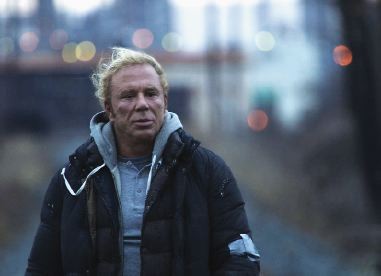The Wrestler

The story of the proud and vital man who has lost his power and nobility is a recurrent theme, especially at the movies. Films have specialized in showing us the washed-up boxer (The Set-Up, Requiem for a Heavyweight, Fat City) and cowboy (Red River, The Gunfighter, Unforgiven). The late director Sam Peckinpah crafted a film career around stories about men who had outlived their time, including lawmen (Ride the High Country), rodeo riders (Junior Bonner) and ruthless killers (The Wild Bunch).
Add to the genre The Wrestler, directed by Darren Aronofsky with Robert Siegel as screenwriter. Mickey Rourke plays Randy “The Ram” Robinson, a professional wrestler celebrated in the 1980s who is barely hanging on 20 years later. His body and soul are scarred, but he is frightened by the thought of moving on to the next chapter of his life. Instead of hanging up his tights and taking on a less physically demanding job, perhaps even one that can utilize his natural charisma and love of performance, he keeps moving down the ladder of the pro wrestling world, finally fighting for pocket money in makeshift rings in VFW Halls and school gymnasiums.
Watching The Ram move through a world of bloody faces and broken chairs is the best thing about this violent but engaging film. The camaraderie of the wrestlers is fascinating to see. They work out beforehand many of the moves and props they will employ during a bout (they use everything from folding chairs to staple guns). To the young warriors, The Ram is still a legend, a man who has been to the mountaintop.
Beyond the scenes of the wrestlers backstage, the screenplay is unextraordinary and many of the subplots are predictable. There is a workable B story about The Ram’s relationship with an aging stripper named Cassidy (Marisa Tomei), and a weak C story about The Ram’s attempts to reestablish contact with his daughter, Stephanie (Evan Rachel Wood). What makes The Wrestler climb up on the ropes and crow is the uncanny performance by Rourke. He has been absent from mainstream cinema for years, and one is tempted to conclude from this film that he spent time researching this role. (Rourke, a notoriously eccentric actor, did box professionally for a while, which helped mash up his once handsome and boyish face.)
Seeing the sparkle in Randy’s eye when he looks at Cassidy, Stephanie, the kids who live outside his trailer, or even a promoter who is chatting him up at a run-down autograph session, it’s easy to remember why Rourke was once a star.
Rourke is powerful not so much in the big-ticket scenes—like when he takes the microphone and addresses the blood thirsty crowd one last time—as in the more intimate scenes, as when he goes shopping with Cassidy at a thrift store to find a gift for his daughter or adjusts the weight on a pound of potato salad at the deli counter where he works part-time. As he moves creakily from his bed to the toilet in the morning, we can feel his pain. When he raises his arms in victory over a vanquished “heel” in the ring, we can sense his ecstasy.
The Wrestler has plenty of foul language, brutal violence and unpleasant sex. But it also contains a generous helping of understated humor, especially for those who lived through the 1980s. And Aronofsky gives the film a wonderful pacing, showing the skill that he exhibited in his debut film, Pi, and later in the disturbing Requiem for a Dream and the flawed but ambitious The Fountain. The Wrestler is his most traditional film to date, in terms of both narrative and technique, but he has not so much abandoned his experimental roots as he has incorporated what he learned from those experiments into a more orderly structure.
Many critics have referred to The Wrestler as a story of redemption, but The Ram is a not a man who needs to be redeemed from past sins. He’s just a man who has wrestled too long. He knows it, and thanks to the performance by Holly wood survivor Rourke, the viewer knows it too.




